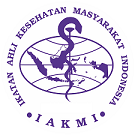Meta-Analysis: The Effect of Anemia in Pregnant Women on the Risk of Postpartum Bleeding and Low Birth Weight
DOI:
https://doi.org/10.26911/thejmch.2023.08.01.06Abstract
Background: Anemia in pregnancy usually occurs in the 1st and 3rd trimesters with Hb levels below 11g% and in the 2nd trimester with Hb levels less than 10.5g%. The prevalence of anemia in pregnant women around the world ranges from 41.8% to 43.8%, which means that around 56-59 million pregnant women suffer from anemia. Factors that cause anemia that often appear in pregnant women are malnutrition and iron deficiency, so that iron anemia in pregnancy can result in increased maternal mortality rates (MMR). Anemia during pregnancy can result in fetal death, abortion, birth defects, low birth weight and can cause bleeding during labour.
Subjects and Method: Meta-analysis was carried out using the PRISMA flowchart and the PICO model (Population: pregnant women, Intervention: anemia, Comparison: no anemia, Outcome: LBW and postpartum hemorrhage). The databases used are PubMed, Research Gate, Science Direct, and Google Scholar with the keywords
How to Cite
References
Aditianti A dan Djaiman SPH (2020). Meta analisis: pengaruh anemia ibu hamil terhadap berat bayi lahir rendah (Meta-analysis: the effect of anemia in pregnant women on low birth weight babies). Jurnal Kesehatan Reproduksi, 11(2): 163-177.https://doi.org/10.22435/kespro.v11i2.3799.163-177
Bhaskar RK, Deo KK, Neupane U, Chaudhary Bhaskar S, Yadav BK, Pokharel HP, Pokharel PK (2015). A case control study on risk ractors associated with low birth weight babies in Eastern Nepal. Int J Pediatr. 2015: 1–7. https://doi.org/10.1155/2015/807373
Biswas P, Samsuzzaman M, Chakraborty A, Das DK (2019). Maternal anemia and low birth weight in a community development block of Purba Bardhaman, West Bengal: a retrospective cohort analysis. IJCMPH, 6(12): 5250.https://doi.org/10.18203/23946040.ijcmph20195480
Borovac-Pinheiro A, Ribeiro FM, Pacagnella RC (2021). Risk factors for postpartum hemorrhage and its severe forms with blood loss evaluated objectivelya prospective cohort study. Rev. Bras. de Gineco e Obstet. 43(2): 113–118. https://doi.org/10.1055/s00401718439
Butwick A, Walsh E, Kuzniewicz M, Li S, Escobar G (2017). Patterns and predictors of severe postpartum anemia after caesarean section. HSS Public Access, 67(1): 36–44. https://doi.org/10.1111/trf.13815.Patters
Carpenter RM, Billah SM, Lyons GR, Siraj MS, Rahman QS, Thorsten V, McClure EM, Haque R, Petri WA (2021). Ushaped association between maternal hemoglobin and low birth weight in Rural Bangladesh. AJTHAB, 106(2): 424–431. https://doi.org/10.4269/ajtmh.210268
Chu FC, Shao SS W, Lo LM, Hsieh TT, Hung TH (2020). Association between maternal anemia at admission for delivery and adverse perinatal outcomes. J Chin Medi Assoc. 83(4): 400–405. https://doi.org/10.1097/JCMA.0000000000000215
Detlefs SE, Jochum MD, Salmanian B, McKinney JR, Aagaard KM (2022). The impact of response to iron therapy on maternal and neonatal outcomes among pregnant women with anemia. Am J Obst Gynecol. MFM, 4(2): 100569. https://doi.org/10.1016/j.ajogmf.2022.100569
Dinkes Bantul (2021). Profil kesehatan kabupaten Bantul tahun 2021 (Bantul district health profile in 2021) 1–47. https://doi.org/10.31292/jta.v3i3.129
Gonzales GF, Tapia V, Gasco M, Carrillo CE, Fort AL (2012). Association of hemoglobin values at booking with adverse maternal outcomes among Peruvian populations living at different altitudes. Int. J. Gynecol. Obstet., 117(2): 134–139.https://doi.org/10.1016/j.ijgo.2011.11.024
Harrison RK, Lauhon SR, Colvin ZA, Mc-Intosh JJ (2021). Maternal anemia and severe maternal morbidity in a US cohort. Am. J. Obstet. Gynecol. MFM, 3(5): 100395. https://doi.org/10.1016/j.ajogmf.2021.100395
Ikeanyi EM, Ibrahim AI (2015). Does antenatal care attendance prevent anemia in pregnancy at term?. Nigeri. J. Clin. Pract., 18(3): 323–327. https://doi.org/10.4103/11193077.151730
Jwa SC, Fujiwara T, Yamanobe Y, Kozuka K, Sago H (2015). Changes in maternal hemoglobin during pregnancy and birth outcomes. BMC Pregnancy and Childbirth, 15(1): 1–10. https://doi.org/10.1186/s1288401505161
Kemenkes RI (2017). Situasi kesehatan reproduksi remaja (adolescent reproductive health situation). In situasi kesehatan reproduksi remaja (Issue Remaja: 1-8). https://www.kemkes.go.id/download.php?file=download/pusdatin/infodatin/infodatinreproduksi remajaed.pdf
Larumpaa F, Suparman E, Lengkong R (2017). Hubungan anemia pada ibu hamil dengan kejadian persalinan prematur di RSUP Prof Dr. R. D. Kandou Manado (The relationship between anemia in pregnant women and the incidence of preterm labor at Prof Dr. R.D. Kandou Manado). E-CliniC, 5(1): 11–15. https://doi.org/10.35790/ecl.5.1.2017.14700
Manuaba IB (2012). Pengantar kuliah obstetri (Introduction to obstetrics courses). Trans Info Media.
Masukume G, Khashan AS, Kenny LC, Baker PN, dan Nelson G. (2015). Risk factors and birth outcomes of anaemia in early pregnancy in a nulliparous cohort. PLoS ONE, 10(4): 1–15. https://doi.org/10.1371/journal.pone.0122729
Nair M, Choudhury MK, Choudhury SS, Kakoty SD, Sarma UC, Webster P, Knight M (2016). Association between maternal anaemia and pregnancy outcomes: A cohort study in Assam, India. BMJ Global Health, 1(1): 1–9. https://doi.org/10.1136/bmjgh2015000026
Rahadinda A, Utami K, Reski S (2022). Hubungan anemia dengan kejadian bayi berat lahir rendah pada ibu hamil di RSUD Abdul Wahab Sjahranie Samarinda (The relationship between anemia and the incidence of low birth weight babies in pregnant women at Abdul Wahab Sjahranie General Hospital, Samarinda). FJST. 1(1):1–6. https://doi.org/10.24903/kujkm.v1i1.840
Rukuni R, Bhattacharya S, Murphy MF, Roberts D, Stanworth SJ, Knight M (2016). Maternal and neonatal outcomes of antenatal anemia in a Scottish population: A retrospective cohort study. Acta Obst. et Gynecol. Scand., 95(5): 555–564. https://doi.org/10.1111/aogs.12862
Shi H, Chen L, Wang Y, Sun M, Guo Y, Ma S, Wang X, Jiang H, et al. (2022). Severity of anemia during pregnancy and adverse maternal and fetal outcomes. JAMA Network Open, 5(2): 1–13. https://doi.org/10.1001/jamanetworkopen.2021.47046
Soh KL, Tohit ERM, Japar S, Geok SK, Rahman NBA, Raman RA (2015). Anemia among antenatal mother in urban Malaysia. J Biosci Med. 03(03): 6–11. https://doi.org/10.4236/jbm.2015.33002
Sun C F, Liu H, Hao YH, Hu HT, Zhou ZY, Zou KX, Liu XM, Sheng JZ, Ding GL, Huang HF (2021). Association between gestational anemia in different trimesters and neonatal outcomes: a retrospective longitudinal cohort study. World J Pediatr. 17(2): 197–204. https://doi.org/10.1007/s12519021004116
Tarwoto, Wasnidar (2013). Anemia pada ibu hamil: konsep dan penatalaksanaan (Anemia in pregnant women: concept and management). Trans Info Media











